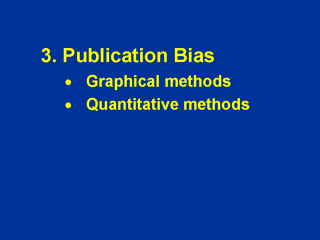 |
One of the most serious forms of
potential bias is publication bias, that is, the tendency for authors to submit and/or
editors to publish, studies that yield statistically significant results. Both graphical
(funnel plot, quantile plot, etc.) and/or quantitative approaches (regression, trim and
fill, etc.) exist for dealing with this potential form of bias. The funnel plot is one of
the more popular approaches for dealing with potential publication bias. Duval and Tweedy
have recently developed a very nice formalization of the funnel plot using simple
rank-based data augmentation techniques for estimating the number of missing studies that
might exist in a meta-analysis and what the effect might be on the outcome (See: Duval S,
Tweedie R. A nonparametric "trim and fill" method of accounting for publication
bias in meta-analysis. Journal of the American Statistical Association 95:89-98,
2000; Duval S, Tweedie R. Trim and fill a simple funnel-plot-based method of testing and
adjusting for publication bias in meta-analysis. Biometrics 56:455-463, 2000). |
